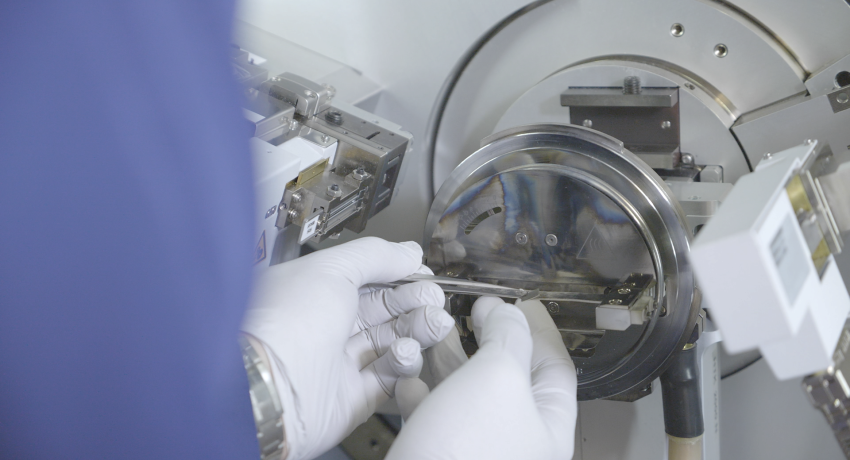A researcher handles a sample in the X-ray diffraction lab in the Materials Characterization Lab. Photo: Cory Beasley
By Jamie Oberdick
When optical networking company Infinera was acquired by telecommunications giant Nokia in early 2025, it was hailed as a strategic move that would solidify Nokia’s leadership in data transport technology. But behind this $2.3 billion deal lies a story of innovation that’s been quietly unfolding in central Pennsylvania, thanks to a long-standing partnership between Infinera and Penn State’s Materials Research Institute (MRI).
For more than a decade, Infinera, now part of Nokia, has been tapping into the cutting-edge tools and collaborative environment at MRI to drive forward its most advanced research and development projects. From surface analysis to nanofabrication, the facilities and expertise at MRI have helped Infinera push the boundaries of fiber optics technology.
"They initially approached us to do some testing, which led to more projects, and over time we sort of became their go-to lab for certain types of measurements,” said Jeff Shallenberger, associate director of the Materials Characterization Lab (MCL). “They're located fairly close about two hours away, and one of their senior people is a materials science graduate from Penn State. He's pretty high up in the semiconductor world, but very hands-on. He likes to come up here and see his samples in person."
“Back in 2015, we started using the MRI facilities because they had equipment we just couldn’t afford or justify in-house,” said John Osenbach, a fellow at Infinera/Nokia and the Penn State alumnus Shallenberger was referring to. “It began with analytical techniques like Auger, XPS, SEM, FIB, and X-ray work. Over time, the collaboration deepened and expanded, especially as our technical challenges became more complex.”
As a company specializing in optical systems, devices that convert digital signals into light for fiber optic communication, Infinera's work sits at the intersection of materials science, engineering, and applied physics. Developing these modules requires extreme precision, advanced materials, and rapid prototyping, all areas where MRI excels.
Osenbach notes that the Millennium Science Complex at University Park, home to MRI’s world-class Nanofabrication Lab and Materials Characterization Lab, was a major factor in deciding to partner with Penn State. These facilities include a 9,500-square-foot cleanroom and specialized “quiet labs” built to minimize vibrations and electromagnetic interference, allowing for atomic-level precision.
But according to both Osenbach and his colleague Michael Vecchio, another Penn State alum and hardware reliability engineer, it’s not just the tools that make MRI an invaluable partner, it's the expertise and willingness to collaborate of its people.
“The expertise is just phenomenal,” Osenbach said. “When I talk with someone like Jeff Shallenberger about best characterization approach for a particular issue we are working, I can say, ‘Here’s what I’m trying to see — can we do this?’ And Jeff knows how to get us there. He knows how to tweak the process, adjust the resolution, and make it work. That level of collaboration is incredibly rare.”
Vecchio echoed that sentiment: “There’s massive benefit in being able to sit down in a lab and work alongside the people running the equipment. We’ve made real-time decisions together over Zoom calls, looking at samples live. That kind of speed and flexibility is something you don’t often get through collaboration.”
In the last 16 months alone, Osenbach and his team have spent more than 20 trips working hands-on in MRI’s cleanroom to develop a new proprietary process. This work is directed at leading edge products to meet the accelerating bandwidth, power, and cost challenges imposed by the industry. The success of that work helped position Infinera for its acquisition by Nokia, which aims to use Infinera’s technology to power next-generation optical networks, which are in many ways the backbone of our digital world.
“Before their Nokia merger, John would tell you they’re a smaller company in the semiconductor world and to stay competitive, they really rely on access to resources like MRI that let them punch above their weight,” said Josh Stapleton. “A smaller company is not going to build a $5 billion nanofab, but by working with us, they get access to cutting-edge fabrication and characterization capabilities. And it's not just about access, because the co-location of facilities and the flow of expertise between them creates real synergy. They’re not just collecting data, they’re using it to innovate.”
Beyond technical innovation, this partnership has broader implications for Pennsylvania and beyond. By enabling high-tech companies like Infinera to thrive, Penn State plays a direct role in boosting the state's innovation economy and workforce development.
“We’re not just using Penn State’s tools,” said Vecchio. “We’re training early-career engineers there, building relationships with faculty, and creating a feedback loop between academic research and industrial application.”
Osenbach noted that the collaboration has enriched both sides.
“We learn a ton from MRI’s experts, but I think they benefit too,” Osenbach said. “We bring real-world problems, things you don’t necessarily see in academic research. That applied lens gives their team a better sense of how their tools and techniques impact industry, and I think that enhances their ability to support other companies down the line.”
The work also contributes to solving global challenges. As the demand for high-speed internet, cloud computing, and AI infrastructure skyrockets, innovations in optical networking are essential for building sustainable, efficient, and scalable communications systems. Through this partnership, MRI is playing a role in ensuring that the digital backbone of the world can keep up with future demands, and all while supporting Pennsylvania talent and industry.
“Working with MRI accelerates everything we do,” Vecchio said. “From failure analysis to materials selection, they help us move faster and smarter. That means better products and more competitive technologies, right here in Pennsylvania.”
As Nokia integrates Infinera’s capabilities into its global operations, the foundation built through the partnership with MRI will remain a key asset. The collaboration exemplifies how academic institutions can fuel innovation not just in theory, but in practice, which is helping companies grow, helping people connect, and helping society advance.
“It’s been one of the most enjoyable parts of my job,” Osenbach added. “It gets me out of the office, back in the lab, and working alongside brilliant people. That kind of partnership? You can’t put a price on it.”

